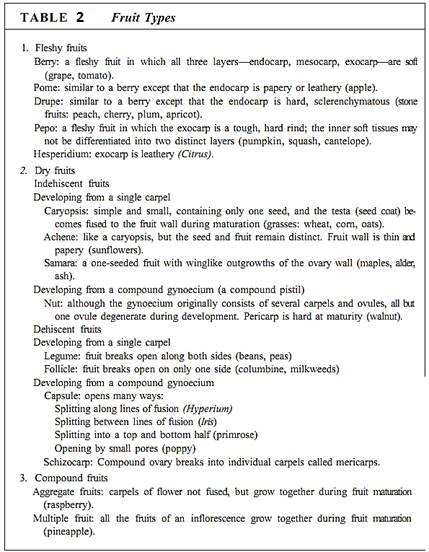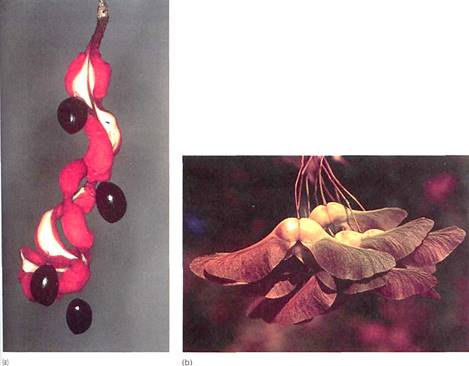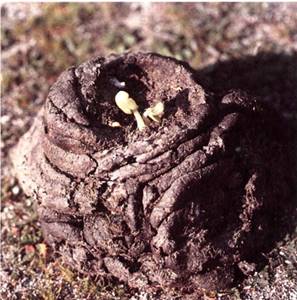


 النبات
النبات
 الحيوان
الحيوان
 الأحياء المجهرية
الأحياء المجهرية
 علم الأمراض
علم الأمراض
 التقانة الإحيائية
التقانة الإحيائية
 التقنية الحيوية المكروبية
التقنية الحيوية المكروبية
 التقنية الحياتية النانوية
التقنية الحياتية النانوية
 علم الأجنة
علم الأجنة
 الأحياء الجزيئي
الأحياء الجزيئي
 علم وظائف الأعضاء
علم وظائف الأعضاء
 الغدد
الغدد
 المضادات الحيوية
المضادات الحيوية|
Read More
Date: 29-10-2016
Date: 17-10-2016
Date: 29-10-2015
|
Fruit Types and Seed Dispersal
Fruits are adaptations that result in the protection and distribution of seeds. Many different agents disperse fruits and the seeds they contain: Gravity, wind, water, and animals are the most common (Table 1). The principles involved in fruit function are somewhat opposed to each other: Fruits that are tough and full of fibers or sclereids, such as pecans, walnuts, brazilnuts, and coconuts, offer maximum protection but are heavy and expensive metabolically. Also, the protected seed must be able to break out to make germination possible; a more fragile fruit is better for that. If animals are to disperse the seeds, part of the fruit must be edible or otherwise attractive while the seed and embryo must be protected from consumption. A division of labor often occurs—some parts being protective, others attractive, and still others allowing germination.

TRUE FRUITS AND ACCESSORY FRUITS
The term "pericarp" refers to the tissues of the fruit regardless of their origin. In most cases, this is the ovary wall, but in many species, especially those with inferior ovaries, the receptacle tissues or septal, petal, and stamen tissues may also become involved in the fruit. The terms "pericarp" and "fruit" have been applied to both types of fruit, so now the term true fruit is used to refer to fruits containing only ovarian tissue, and accessory fruit (or false fruit) is used if any nonovarian tissue is present (Fig. 1). Apples develop from inferior ovaries and the bulk of the fruit is enlarged bases of sepals and petals; only the innermost part is true fruit derived from carpels .
Fusion of carpels also affects the nature of fruits. If the fruit develops from a single I ovary or the fused ovaries of one flower, it is a simple fruit, the most common kind. If the separate carpels of one gynoecium fuse during development, an aggregate fruit results, such as raspberries. If during development all the individual fruits of an inflorescence fuse into one fruit, it is a multiple fruit, as in figs, mulberries, and pineapple (Fig. 1b). These are also largely accessory fruits because in addition to the ovary tissue, the inflores-I cence axis, bracts, and various flower parts contribute to the mature fruit.

FIGURE 1 (a) The red, edible flesh of strawberry is really the receptacle, not carpel tissue, so it is an accessary fruit. The "seeds" are true fruits, each derived from one carpel of the flower. (b) Pineapples develop from the coalescence of all the many true fruits of one inflorescence, so it is a multiple fruit. In addition, many noncarpellary tissues become involved, so it is an accessory fruit as well. Bracts are visible here. (Courtesy of Dole, Inc.)
CLASSIFICATION OF FRUIT TYPES
There are several ways of grouping or classifying fruits. In one method, emphasis is placed On whether the fruit is dry or fleshy. A dry fruit is one that is not typically eaten by the , natural seed-distributing animals; fleshy fruits are those that are eaten during the natural seed distribution process.
A further classification of dry fruits emphasizes fruit opening: Dehiscent fruits break open and release the seeds, whereas indehiscent fruits do not (Table 2). For the most part, fleshy fruits are indehiscent. Animals chew or digest the fruit, opening it; if uneaten, the fruit rots and liberates the seeds. Although many dry fruits are dehiscent, others must rot or the seed must break the fruit open itself.
Perhaps the simplest fruits are those of grasses: Each fruit develops from one carpel containing a single ovule. During maturation, the seed fills the fruit and fuses with the fruit wall, which remains thin. It has little protection and no attraction for animals. The fruit seed falls and germinates close to the parent sporophyte. The fruits are indehiscent, and during germination the embryo absorbs water, swells, and bursts the weak fruit. These fruits are caryopses.

Beans and peas form from a single carpel that contains several seeds. The fruits, known as legumes, are dry and inedible (except to humans and insects) like caryopses but do not fie to the seeds. At maturity, the two halves of the fruit twist and break open (dehisce) along the two specialized lines of weakness (Fig. 2). After liberation from the legume, the seeds are protected from small animals and fungi only by the seed coat.
Fruits or seeds carried by wind must be light; they often have wings (maples) or parachutes (dandelions) that keep them aloft as long as possible. Such fruits are dry and i weight much less than 1 g. Fruits and seeds that are transported by water (ocean currents, streams, floods) can be larger and heavier, but they must be buoyant and resist mildew and [rot. An excellent example is coconuts that float from one island to another.

FIGURE 2:At maturity different layers in the fruit contract in opposite directions, causing the pod to twist and break open. (b) As these maple fruits drop, the wings cause them to rotate and float, thus remaining aloft and traveling much farther on the wind.
Animals carry fruit in a variety of ways. Dry fruits with hooks or stickers catch onto animal fur or feathers; sticky, tacky fruits glue themselves onto animals; and fleshy, sweet, colorful fruits are eaten. Edible fruits require particular specialization because the fruit must be consumed but the seeds must not be damaged; they must not be crushed by teeth or gizzard or be digested. fmmature fruits deter frugivores by being hard, bitter, or sour, such as unripe apples or bananas. At maturity, the fruit is soft, sweet, flavorful, and typically strikingly different in color. The enclosed seeds often have hard seed coats or endocarps (peach, cherry) that allow them to pass through an animal unharmed .
Grapes and tomatoes are examples of simple fleshy fruits: They are berries because all parts of the fruit are soft and edible (Table 2). The seed coat provides some protection against being crushed during chewing, but perhaps more important are the size of the seeds and their slippery seed coat, which allows the seeds to slip out from between our molars. Pomes (apples and pears) differ from berries in two ways. First, they develop from inferior ovaries, so the inner tissue is the true fruit and the outer tissue is accessory fruit. Second, the seeds are protected because the innermost fruit tissues, the cores, are bitter and tough. The most elaborate fleshy fruits are drupes, in which the innermost tissues, the endocarp, are extremely hard and totally inedible, full of sclerenchyma. The mesocarp becomes thick, fleshy, juicy, and sweet and the exocarp forms the peel, whose color informs the frugivores of the fruit's ripeness. Drupes provide maximum attraction to animals with minimum danger to the seed.
Because frugivores are a major danger to seeds, it is necessary to think about how edible fruits evolved: They must offer some advantage that outweighs the danger. Animals have predictable habits and migration patterns. Ants, birds, and mammals carefully select the sites where they feed, nest, and sleep; therefore, seeds are not distributed at random but are moved through the environment to specific sites. One example is mistletoe: Its seeds are sticky and adhere to a bird's beak as it eats the fruit. The bird probably feeds and cleans itself in the same species of tree, so the seeds are rubbed off the beak directly onto a proper host tree. Few seeds are ever lost by dropping to the ground or being deposited in the wrong tree, as would happen with wind or water dispersal. Just as efficient is dispersal of fruits and seeds of marsh plants. The birds and animals that live in marshes typically spend little or no time in other habitats, so seeds carried by these animals are almost certainly distributed to favorable sites.
A special benefit of seed distribution by animals is that the "deposited" seed may find itself in a small (or large) mound of "organic fertilizer" (Fig. 3). Seeds that are adapted to pass through an animal's digestive tract are resistant to digestive enzymes and can tolerate the high level of ammonium in fecal matter. Because many seeds of plants cannot tolerate these two factors, the adapted seeds find themselves in a microenvironment that is not only nutrient-rich but also excludes some competitors.

FIGURE 3:This seedling is as happy as a clam at high tide: It has enough fertilizer to last for months. Many of its competitors have been digested; others are being suffocated.



|
|
|
|
تفوقت في الاختبار على الجميع.. فاكهة "خارقة" في عالم التغذية
|
|
|
|
|
|
|
أمين عام أوبك: النفط الخام والغاز الطبيعي "هبة من الله"
|
|
|
|
|
|
|
المجمع العلمي ينظّم ندوة حوارية حول مفهوم العولمة الرقمية في بابل
|
|
|